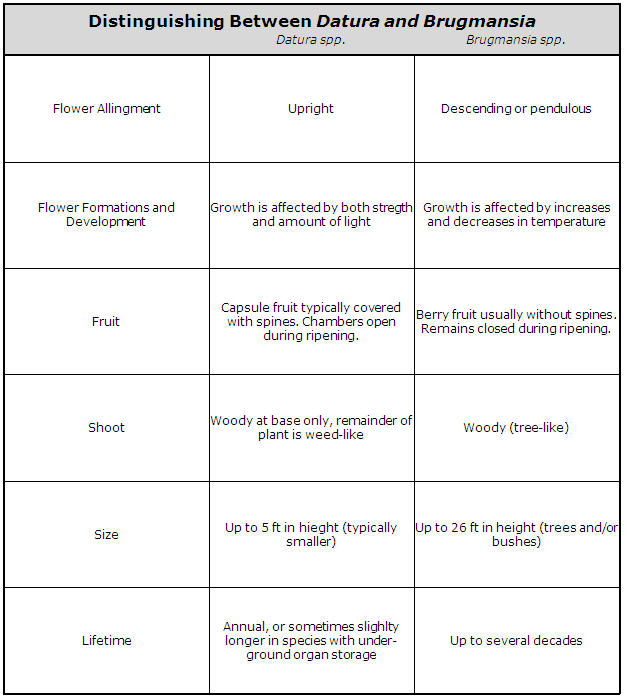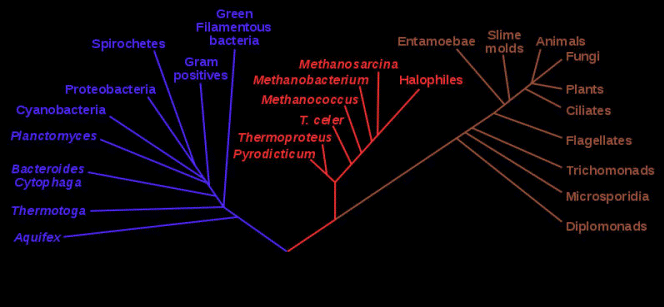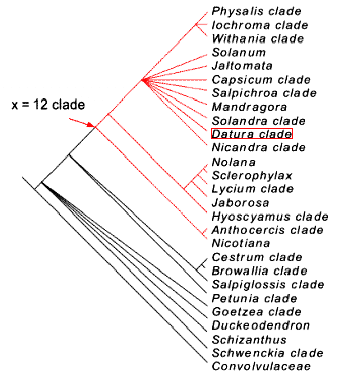Classification
_________________________________________________________
Taxonomic classification of
Datura stramonium
*Under each classification is another example
organism from our host site,
Multiple Organisms*
The following is the hierarchical classification of the species Datura stramonium, it has been derived from morphological, molecular, and evolutionary relationships.
Domain - Eukarya
Organisms under this
domain are eukaryotic, meaning that they have
membrane bound organelles and a true nucleus. The
diverse array of organisms included in this domain
compose the majority of well known species.
Kingdom - Plantae
Organisms under the
kingdom plantae are unified because of their dependence on a cell
wall and chloroplasts. Resultantly, the majority of these organisms
are solely photoautotrophic.
Division/Phylum
- Magnoliophyta
Organisms under this
division (the botanical term for phylum) are commonly known as the
angiosperms, or flowering plants. This trait is linked to how they
reproduce.
Class
- Magnoliopsida
This phylum is commonly known as
the dicotyledons. This group of
flowering plants is distinguished by have two cotyledon, in addition
to having petals in multiple of four or five.
Order - Solanales
This order, commonly
known as the potato order, contains five families of
organisms; many of which have been cultivated around
the world for thousands of years.
Family - Solanaceae
Organisms under this
family compose the commonly known nightshades. Among other common
morphological characteristics, this family is many times known for
the production of alkaloids
Genus - Datura
Nine specie belong to this
genus, however recently Datura spp. have been reclassified
as Brugmansia spp.
Species - Datura stramonium
Commonly known by the
name jimson weed, this species actually derives its name from the
Hindu vernacular, Dhatura. Stramonium on the other hand
originates from Latin, meaning spiked fruit. The name is fitting as
jimson weed has also earned the name, the thorn apple, after its
extremely veracious and spiked fruits.
_________________________________________________________
Phylogeny
_________________________________________________________
Phylogenetic trees are an easy way to illustrate relationships between many species or for that matter between any two organisms. The two tree's below represent multiple ways to analyze Datura stramonium's past. It's important to take note that these trees should be treated in a fluid manner as they are constantly changing with the introduction of new techniques and molecular data.
Domain Classification
The basic phylogenetic tree of life is shown above. The three colors blue, red, and brown illustrate the three separate domains. Within the Brown section or the Eukarya Domain, there are some of the separate kingdoms. Because of the diverse nature of life, some of the phylogenetic classifications have been left out of the tree above. To the far right the characteristic and commonly known kingdoms are displayed; the animals, the fungi, and the plants.
Family Classification
This tree is backed by molecular data and shows the phylogeny of the family Solanaceae. The red area indicates a monophyletic group, who share a common ancestor located where the red arrow is below.
_________________________________________________________
Genus Identification
_________________________________________________________
If the content above doesn't suit your needs, here is how you can distinguish Datura stramonium in your own back yard!
The Datura spp. as a weed is many times admired for its beautiful flowers and intense aroma, however it is also many times confused with a closely related genera Brugmansia. By their common names angle’s trumpets (Brugmansia) and thorn apples (Datura) have several differences, that can be distinguished in the table below.
Notice: the key difference falls in the alignment of the flowers and whether or not the plant is tree-like or weed-like, but as seen there are other defining criteria.

Being that
jimson weed is the topic of
discussion, the following list will distinguish the
species Datura stramonium from the other
species in the Datura genus. One offsetting factor in the Datura Stramonium
species is the possibility of smooth fruits. This is
because although spiny fruits will always occur,
they can be in combination with smooth ones.
-
Plants are weed-like with upright flowers
- Fruits are upright
- Fruits are covered with spines of the same length
- Plants are green with white flowers
To see if Datura stramonium is in your area continue to the habitat page
...Or return to the home page for a fresh start.


